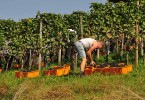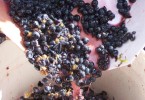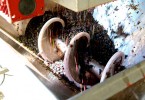Producing wine step by step
It dominates the Italian tables from generations: red, white or rosé. It is used to pair our good local food. We are talking about wine one of the products that, from the past, is the strong suit of the Italian agricultural production, recognized all over the world for its quality and tradition.
The international Salon of Wine and Distillates well known as Vinitaly that the city of Verona host every year, is the proof that Italy is beating heart of the production of this alcoholic drink. Everyone knows it, what is unknown, instead is how to produce this extraordinary product: the wine! Which are the phases that allow grapes to become wine?
To produce wine it is necessary to follow some specific phases, starting from the help that the nature can give us to obtain a good wine. In fact, the alcoholic fermentation of the grape juice occurs thanks to the presence of some important yeast on the grapes that are able to transform the sugar of the pulp into ethyl alcohol and CO2.
The first production phases: Grape harvest and pressing
The first step to produce wine and bring it on our table is the grape harvest: an activity that was historically carried out by hand by the peasants is now managed by machines that automatically remove the grapes from the vines and collect them in wide tanks, ready for the next production phase, the pressing. This passage was managed without machines but with the beloved crushing with the feet by peasants and their wives. Now, instead, this activity is carried out by automatic machines that allow to obtain the must from the grapes. Then, it is necessary to adjust the mix with substances that purify it from the dross and regulate the level of acidity.
Fermentation and vinification: the different steps between white and red wine
At this point we are in the middle of our work. To produce wine there are some steps to follow. The fermentation phase has a variable duration based on the grapes and the wine that you have to produce: usually the necessary time can vary from a day to a week, but can also reach 10 days for the most structured and strong wines. During this period the chemical transformation take place and the sugar becomes, slowly, alcohol and carbon dioxide.
In this phase you can decide if you can obtain a white, rosé or red wine. The secret is the fermentation of the must, together with the pomace. If we refer to white wine, here the vinification is really short and above all the complete lack of pomace. In this way, increasing the time of fermentation and maceration, together with the peels of the grapes we obtain gradually rosé wines and then always more intense red wines according to the period of resting of the must together with the pomace.
Purification of the wine before arriving in the table: racking and ageing
We are close to the goal to know how to produce wine. At the end of the vinification, long or short, based on the type of wine that you want to produce, it is necessary to purify the content of the liquid from the impurity given by the residuals that sediment in the bottom of the tub and the pomace that have to be divided from the mix, to pour everything in the barrels. Here the so-called barrel fermentation take place, a kind of secondary fermentation which sugary residual in the wine will become alcohol.
This phase is usually short for white wines: there is the possibility to bottle in a small period of time. For red wines, instead, the process of ageing is pretty important and can reach also 5 years.
The most used types of barrels in the last years are barrique, a small durmast barrel that give to the wine a soft and round taste, like a nougat or vanilla. This happens because the wood of this small barrel in contact with wine releases easily its aromas. The more is the period of ageing, the more will be the round taste of the wood in the palate.
Once bottled, the wine is ready to be tapped and tasted in good company, for two or during a evening with friends to toast together with the amazing notes that this wine can give.







